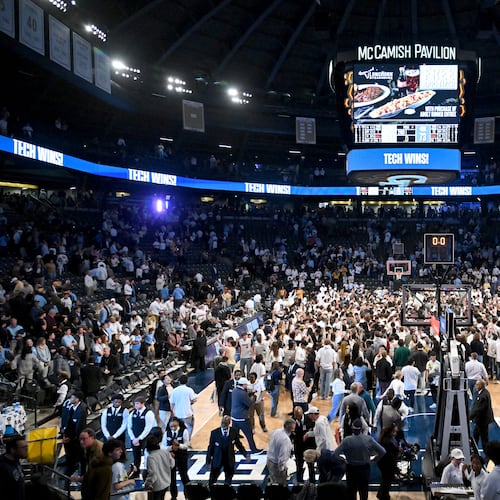It was only one play out of two weeks of preseason camp, but Dylan Leonard couldn’t have executed it much better. Lining up on the right side of the line as an H-back in an 11-on-11 drill, the Georgia Tech tight end moved left at the snap as the play – a handoff – went to the right end.
Leonard drove up and into the defensive end covering the backside of the play, ultimately putting him on the ground.
As much as the Milton High grad loves the pass-catching aspect of his position, it’s blocking of that sort that will likely increase his chances to be on the field to be a downfield target for quarterback Jeff Sims.
“What I’ve learned over these past two years is blocking is more of a mindset than anything,” Leonard said. “You’ve got to go in there looking to take someone’s head off, and then also you’ve got to rely on your technique, your form and stuff like that.”
For Leonard and fellow tight end Dylan Deveney, the blocking part of the job has been slower to develop. Last season, the two were inconsistent as blockers, both in the run and pass game. Sometimes able to pass protect in the pocket or throw blocks in the run game and sometimes not, Leonard and Deveney were willing but not always effective.
It has been part of their growth. As a tight end at Milton High, Leonard was a receiver first. Also, needing to gain mass to handle ACC competition, Leonard said he felt awkward last season as a sophomore with the weight he carried around. After gaining more muscle in the offseason while staying the same 245 pounds, he said he has felt more comfortable and powerful. In the preseason, he said he has felt more confident, focused more on making the most of a play instead of simply not messing it up.
Deveney didn’t start playing football until midway through his senior year at Shawnee High in Medford, N.J., having played baseball and basketball to that point. He arrived at Tech after a post-graduate year. He still has plenty of room to grow.
But they’re getting there. A few plays after Leonard put the end on the ground in the recent preseason practice, Deveney led on a jet sweep, locking in on a defender on the perimeter and aggressively driving him backwards to open up running room. Tight-ends coach Chris Wiesehan rated the two Dylans’ blocking in camp as “exceptional.”
“Like, you’ve never seen what they’ve done, what they’ve put on tape this camp,” he said last week. “They’ve never had that kind of physicality. So we’re excited about that.”
The more they can be viable blockers, the more reason they can give to offensive coordinator Dave Patenaude to keep them on the field, thus increasing their chances to be part of the downfield passing game. Wiesehan suggested the possibility that Tech could play both Deveney and Leonard at the same time in a “12” personnel grouping – one back, two tight ends, two receivers.
“I think that when we got here, we didn’t run a lot of 12,” Wiesehan said. “The last place (Temple), we did run a lot of 12. What’s unique about those guys and their ability and how we run our (position) room is, they could line up at any spot.”
In such a package, Patenaude could line them up all across the offense, as H-backs, on the line in a three-point stance next to a tackle, in the slot or on the outside.
“So that gives you position flexibility with our offense and it can stymie some defensive calls,” Wiesehan said.
The tight ends were not a significant element of the Tech passing game a year ago. Deveney, Leonard and Jack Coco caught a total of 11 passes, 7% of all completions. The issues of the offense last season – Sims’ decision making and accuracy, the line’s pass protection and the receivers’ route running and catching – all played a part.
The expected across-the-board developments figure to increase the tight ends’ targets. Sims has vowed their involvement.
“It’s all of us being in the right spots,” Wiesehan said. “I think you guys are going to see an exciting offense that we’re putting together.”
Wiesehan called the competition between Deveney (six starts in 2020) and Leonard (two starts) “neck and neck.” Coco (one start), Billy Ward and freshman Ben Postma are also competing to play.
“(The player) who’s going to walk out there is going to be the guy that’s going to put their face on people (in blocking) and finish them,” Wiesehan said. “And then who can vertically stretch the field and give us the biggest catch radius to go run and catch the ball down the field. All those guys are pretty good intermediate, but we want to see them get the ball down the field, as well.”
Leonard anticipates that, too.
“I think as we get opportunities more in practice, as we make more plays, the quarterbacks will get more comfortable with us and trust us to give us those jump balls when we’re on DB’s that are smaller than us,” Leonard said. “So what ‘Wiese’ always says is, when you get those opportunities, you’ve got to make most of them, because coach P’s going to remember those plays, whether we make them or not, and so will the QB’s.”
About the Author
Keep Reading
The Latest
Featured


